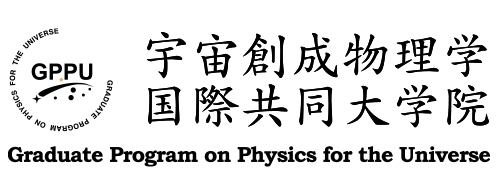GPPU Seminar
1) Investigating Galaxy Mass Growth and "Death" One Billion Years after the Big Bang
2) Measurement of neutron inelastic scattering on 12C for triple alpha process in dense environment
1) Kosuke Takahashi; 2) Shumpei Yamazaki
(Tohoku University)
Date
13:00—15:00, March 26th, 2025Place
(hybrid) Room 745, Science Complex B (H-03), Zoom registration mapAbstract
1) Identifying when massive galaxies first emerged and how their star formation ended (“Galaxy Death”) is crucial for understanding galaxy evolution. Observations show that such galaxies (stellar mass ~10^11 Msun) already existed about 1.2 billion years after the Big Bang (z < 4.9). Our Ruby-Rush program targets even earlier epochs, around one billion years (z ~ 5), to determine whether similarly massive “mature” galaxies—those no longer forming stars—were in place. When star formation ceases, a galaxy’s spectrum exhibits a strong “Balmer break,” indicating that star-forming activity ended roughly 100 million years earlier. Using the Subaru Telescope and two specialized “medium-band” filters (K2 and K3), we discovered a mature galaxy candidate at z ~ 5, illustrating accelerated growth at that epoch. In this seminar, I will discuss our Ruby-Rush program and share JWST results that provide new insights into mature galaxies across a wide range of masses.
2) The triple alpha process is a set of reactions, which produces 12C from three alpha particles in stellar nucleosynthesis. The resonance of 12C, known as the Hoyle state, plays an important role in that process. The Hoyle state de-excites to the ground state of 12C with low probability by mainly radiative de-excitations under typical stellar conditions. In a hot and dense environment such as supernovae, the triple alpha reaction rate can be enhanced by neutron induced deexcitation. In the neutron induced deexcitation, the excited state decays into the bound states by giving its excitation energy to neutrons instead of radiative de-excitation. We plan to measure a cross section of the inverse reaction, expressed in 12C(n, n’), near the reaction threshold energy to determine the enhancement factor of the triple alpha reaction rate. For the measurement of neutron inelastic scattering on 12C, we have been developing a monoenergetic 10 MeV neutron source with 1H(13C, n)13N reaction. In this seminar, I will talk about the physics background and the current status of the development of the 10MeV monoenergetic neutron source, especially a new cryogenic hydrogen gas target.
Point
GSP 1Contact: Kazuhiro Watanabe (kazuhiro.watanabe.b8 [at] tohoku.ac.jp)
